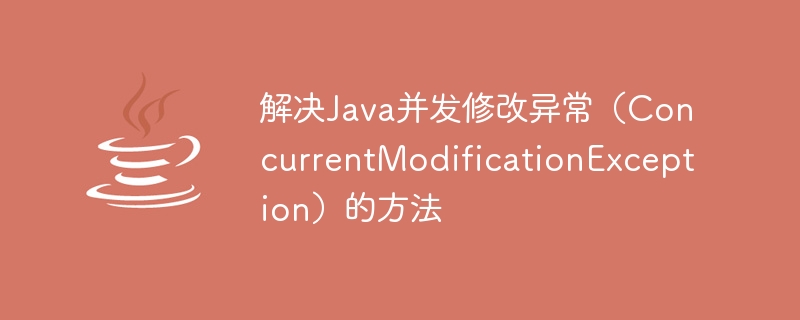Home >Java >javaTutorial >Methods to solve Java concurrent modification exception (ConcurrentModificationException)
Methods to solve Java concurrent modification exception (ConcurrentModificationException)
- WBOYWBOYWBOYWBOYWBOYWBOYWBOYWBOYWBOYWBOYWBOYWBOYWBOriginal
- 2023-08-18 19:12:271206browse

Methods to solve Java concurrent modification exception (ConcurrentModificationException)
In Java programming, when multiple threads read and write a collection at the same time, it is easy to occur Concurrent modification exception (ConcurrentModificationException). This exception usually occurs when using an iterator to traverse a collection, while other threads modify the collection. This article will introduce some common methods to solve this exception and give corresponding code examples.
- Use thread-safe collection classes
Java provides some thread-safe collection classes, such as java.util.concurrent.CopyOnWriteArrayListandjava.util.concurrent.ConcurrentHashMap. These collection classes use a special copy-on-write mechanism to ensure that no concurrent modification exceptions will occur when modification operations are performed during the traversal process. Here is sample code using CopyOnWriteArrayList:
List<String> list = new CopyOnWriteArrayList<>();
list.add("hello");
list.add("world");
Iterator<String> iterator = list.iterator();
while (iterator.hasNext()) {
String element = iterator.next();
System.out.println(element);
list.add("!");
}- Using a synchronized block or lock mechanism
Another way to resolve concurrent modification exceptions is to use Synchronized block or lock mechanism. By ensuring that only one thread can modify the collection when multiple threads access the collection, concurrent modification exceptions can be avoided. The following is a sample code using a synchronized block:
List<String> list = new ArrayList<>();
list.add("hello");
list.add("world");
synchronized (list) {
Iterator<String> iterator = list.iterator();
while (iterator.hasNext()) {
String element = iterator.next();
System.out.println(element);
list.add("!");
}
}- Using iterators of concurrent containers
Java's concurrent container class provides iterators specifically for concurrent access. Use these iterators to adapt to collection modifications during the traversal process and avoid the occurrence of concurrent modification exceptions. The following is a sample code using ConcurrentHashMap:
ConcurrentHashMap<String, Integer> map = new ConcurrentHashMap<>();
map.put("java", 1);
map.put("python", 2);
Iterator<Map.Entry<String, Integer>> iterator = map.entrySet().iterator();
while (iterator.hasNext()) {
Map.Entry<String, Integer> entry = iterator.next();
String key = entry.getKey();
int value = entry.getValue();
System.out.println(key + ": " + value);
map.put("c++", 3);
}- Using the delete method of
Iterator
When traversing the collection, use The remove() method of Iterator can safely remove elements without raising concurrent modification exceptions. The following is a sample code using the remove() method:
List<String> list = new ArrayList<>();
list.add("hello");
list.add("world");
Iterator<String> iterator = list.iterator();
while (iterator.hasNext()) {
String element = iterator.next();
System.out.println(element);
if (element.equals("hello")) {
iterator.remove();
}
}Summary:
Concurrent modification exceptions are one of the common problems in Java programming, but we can use multiple ways to solve it. Using thread-safe collection classes, synchronized blocks or lock mechanisms, iterators of concurrent containers, and deletion methods of Iterator can effectively avoid the occurrence of concurrent modification exceptions. During the development process, choosing the appropriate method to deal with the problem of concurrent access to collections according to specific needs can ensure the stability and correctness of the program.
(The above is an article within 1500 words, titled "Methods to solve Java concurrent modification exception (ConcurrentModificationException)")
The above is the detailed content of Methods to solve Java concurrent modification exception (ConcurrentModificationException). For more information, please follow other related articles on the PHP Chinese website!
Related articles
See more- What are JavaBeans and How Are They Used in Java Applications?
- How to Randomize Multiple ArrayLists While Maintaining Ordering Consistency?
- JDBC SQL Server Driver: Is `setFetchSize()` Really Controlling Memory Usage?
- How do you create a true copy of a two-dimensional array in Java without unintended consequences?
- How to Reliably Parse the Output of `Date.toString()` in Java?

